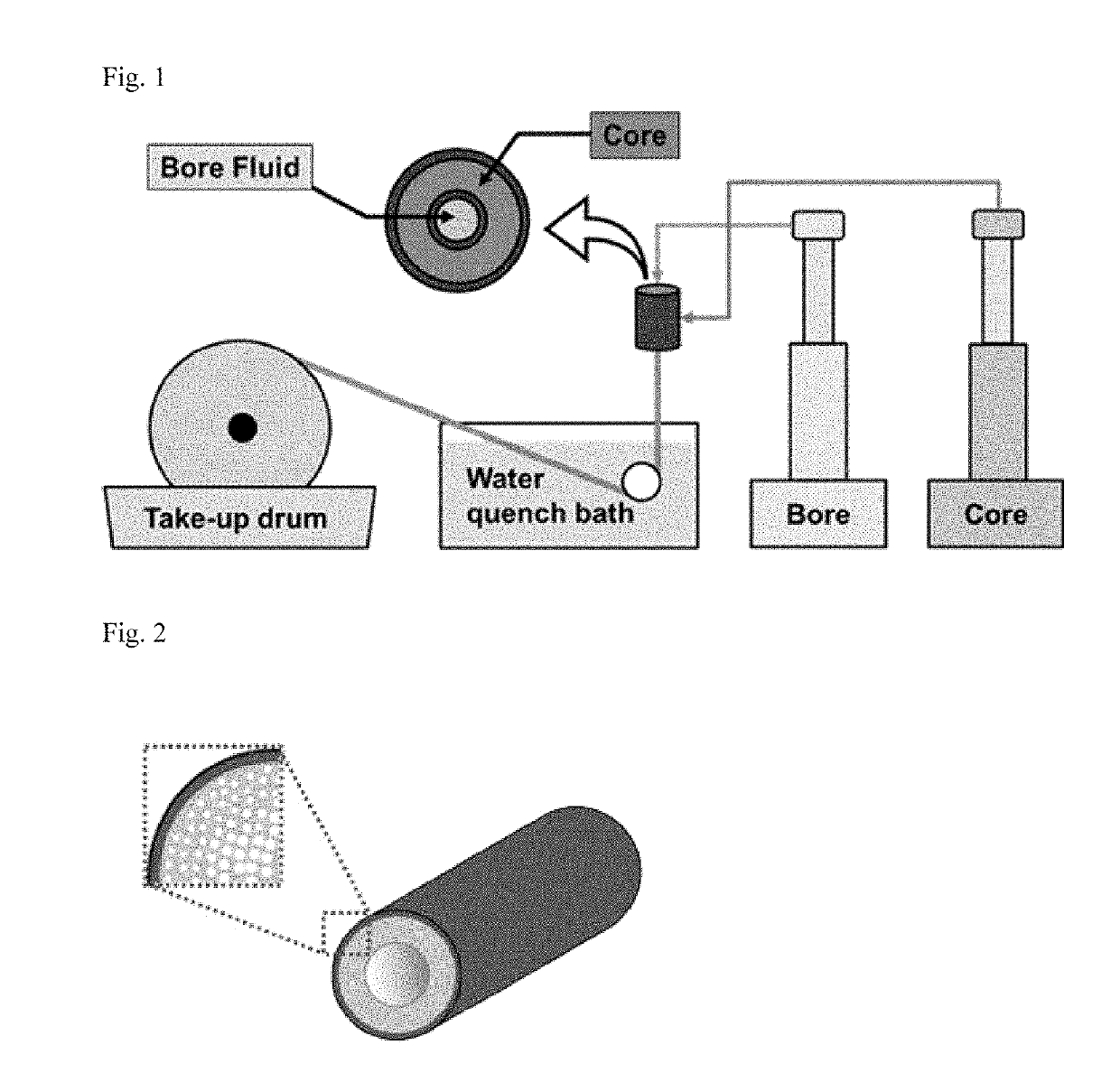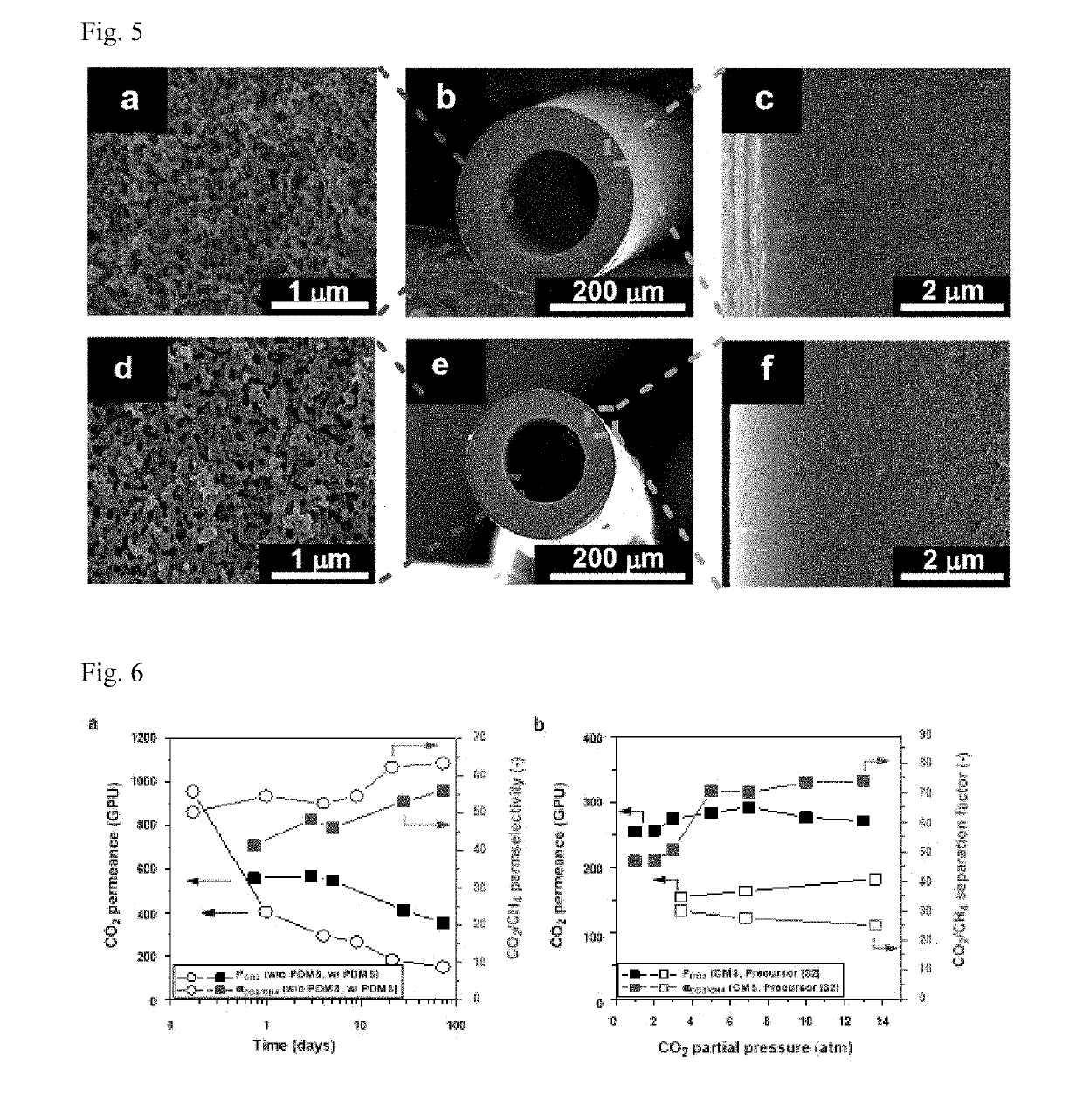Hybrid polymeric hollow fiber membrane, hybrid carbon molecular sieve hollow fiber membrane, and processes for preparing the same
a carbon molecular sieve and polymer technology, applied in membranes, membrane technology, separation processes, etc., can solve the problems of difficult large energy consumption of cryogenic distillation, and low selectivity of gas separation, etc., to achieve excellent gas separation performance, high flux, and simple process
- Summary
- Abstract
- Description
- Claims
- Application Information
AI Technical Summary
Benefits of technology
Problems solved by technology
Method used
Image
Examples
preparation example 1
on Molecular Sieve Hollow Fiber Membrane
[0103]104 ml of N-methyl-2-pyrrolidone (NMP) was added to a mixture of 20 g of 4,4′-(hexafluoroisopropylidene)diphthalic anhydride (6FDA) and 4.06 g of 2,4,6-trimethyl-1,3-diaminobenzene (DAM) / 3,5-diaminobenzoic acid (DABA) (molar ratio of 3:2) to prepare a monomer solution having a concentration of 20% by weight. The mixture was stirred at about 5° C. for 24 hours to obtain a high molecular weight polyamic acid solution. 4.3 g of β-picoline and 43.2 g of acetic anhydride were added to the polyamic acid solution, which was stirred at room temperature for 24 hours for imidization. The precipitated polyimide (6FDA-DAM:DABA (3:2)) was washed with methanol and dried at 180° C. under vacuum for 24 hours to obtain 24.1 g of 6FDA-DAM:DABA (3:2).
[0104]A 100-ml round bottom flask was charged with 0.04 g of potassium carbonate, 4.8 g of deionized water, and 8 g of tetrahydrofuran (THF) to obtain a clear solution. 9.52 g of phenyltrimethoxysilane and 7.2...
preparation example 2
Carbon Molecular Sieve Membrane
[0110]5 g of a polymer mixture of 6FDA-DAM:DABA (3:2) and LPPyr64 in a weight ratio of 80:20 as used in Production Example 1 was completely dissolved in 95 g of tetrahydrofuran (THF). Then, a film was formed by a melting and casting process on a Teflon dish with a Teflon casting ring. To allow gradual evaporation of the solvent, the melting and casting process was carried out in a glove bag saturated with THF. After 12 hours, the vitrified film was dried at 120° C. under vacuum for 12 hours to remove the residual solvent. The dried film was cut into a circular shape, when a sharp die cutter was smashed with a hammer to reduce cutting stress. The film thus obtained had a uniform thickness of 80±10 μm. The film thus obtained was washed, dried, and pyrolyzed in the same manner as in Preparation Example 1 to obtain a flat carbon molecular sieve membrane.
preparation example 3
on Molecular Sieve Hollow Fiber Membrane Coated with PDMS
[0111]The carbon molecular sieve hollow fiber membrane obtained in Preparation Example 1 was coated with poly(dimethylsiloxane) (PDMS). A poly(dimethylsiloxane) resin (Sylgard 184A, Dow Corning) and a crosslinking agent (Sylgard 184B, Dow Corning) were mixed at a weight ratio of 9:1 to obtain a mixture thereof. Heptane was added to the mixture to prepare a coating precursor solution having a concentration of 99% by weight, followed by conducting partial crosslinking by stirring it for 12 hours. The carbon molecular sieve hollow fiber membrane was immersed in this solution for 10 minutes. Thereafter, the carbon molecular sieve hollow fiber membrane was dried at room temperature for 30 minutes and dried at 100° C. under vacuum for 12 hours.
PUM
| Property | Measurement | Unit |
|---|---|---|
| thickness | aaaaa | aaaaa |
| temperature | aaaaa | aaaaa |
| inner diameter | aaaaa | aaaaa |
Abstract
Description
Claims
Application Information
 Login to View More
Login to View More - R&D
- Intellectual Property
- Life Sciences
- Materials
- Tech Scout
- Unparalleled Data Quality
- Higher Quality Content
- 60% Fewer Hallucinations
Browse by: Latest US Patents, China's latest patents, Technical Efficacy Thesaurus, Application Domain, Technology Topic, Popular Technical Reports.
© 2025 PatSnap. All rights reserved.Legal|Privacy policy|Modern Slavery Act Transparency Statement|Sitemap|About US| Contact US: help@patsnap.com



